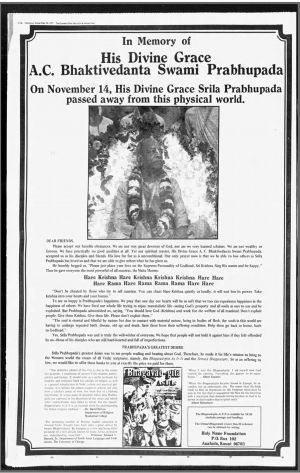Srila Prabhupada in the Media - 1977
Tampa Bay Times, March 13 1977
An Island in the Sun
This Krishna colony co-exists with a skeptical world
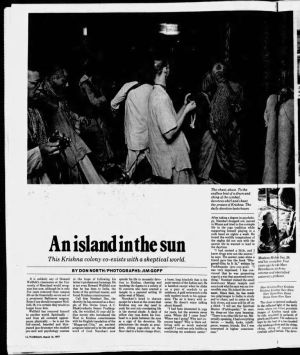
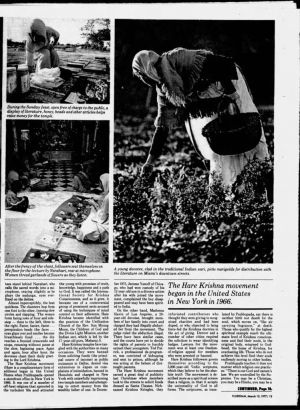
The New York Times, March 18 1977
Judge Rejects Charges of ‘Brainwashing’ Against Hare Krishna Aides
The Hare Krishna movement was called a “bona fide religion” yesterday by State Supreme Court justice in Queens who threw out two indictments against officials of the movement. The indictments had charged them with illegal imprisonment of two members and attempted extortion from the father of one of the believers.
“'The entire and basic Issue before this court,” said Justice John J. Leahy, “is whether or not the‐ two alleged victims in this case and the defendants will be allowed to practice the religion of their choice—and this must be answered with a resounding affirmative.”
The indictments, handed up last year, were the first of their kind against the Hare Krishna movement. They charged that Angus Murphy, the president of the New York temple of the religion, and Harold Conley, the supervisor of women at the temple, held Edward Shapiro and Merylee Kreshour in the temple illegally, by brainwashing them.
Mr. Murphy was also accused of joining Mr. Shapiro in an attempt to extort $20,000 from Mr. Shapiro's father. The allegations were denied by the younger Mr. Shapiro and by Miss Kreshour.
After determining that Miss Kresbouc and the younger Mr. Shapiro had lived voluntarily in the temple at 340 West 55d Street and that there was no case for attempted extortion, Justice Leahy said:
“'The Hare Krishna religion is a bona fide religion with roots in India that go back thousands of years. It behooved Merylee Kreshour and Edward Shapiro to follow the tenets of that faith and their inalienable right to do so will not be trammeled upon.
Continue reading the main story
“The separation of church and state must be maintained. We are, and must remain, a nation of laws, not of men. The presentment and indictment by the grand jury was in direct and blatant violation of defendants’ constitutional rights.”
The judge pointed out that the prosecution, during the hearing last month, had conceded that no physical force had been used by the defendants against Miss Kreshour or the younger Mr. Shapiro, adding:
“The said two individuals entered the Hare Krishna movement voluntarily and’ submitted themselves voluntarily to the regimen, rules and regulations of said so-called Hare Krishna religion, and it is also conceded that the alleged victims were not in any way physically restrained from leaving the defendant organization.” On the allegation of brainwashing, he said:
“'It appears to the court that the people rest their case on an erroneous minor premise to arrive at a fallacious conclusion. The record is devoid of one specific allegation of a misrepresentation or an act of deception on the part of any defendant.
Justice Leahy, who stressed that his decision was intended as a “dire caveat to prosecutional agencies throughout the length and breadth of the land,” cited the constitutional guarantee of freedom of religion said:
“The freedom of religion is not to be abridged because it is unconventional in its beliefs and practices or because it is approved or disapproved by the main stream of society or more conventional region. “Without this proliferation and freedom to follow the dictates of one's own conscience in his search for and approach to God, the freedom of religion will ‘be a meaningless right as provided for in the Constitution.”
Legal and ethical questions have arisen from intensive efforts to “deprogram” members of Hare Krishna and other movements. The main method is to separate the follower from the group and to subject him to long periods of counter-persuasion. Among the controversial and well‐known de-programmers is Ted Patrick, a Californian who was released recently from prison on kidnapping charges resulting from a deprogramming case.
The grand jury was drawn into the Hare Krishna case‐ last September when Hiss Kreshour alleged that she was kidnapped by her mother, Edith, and a private investigator in Queens and subjected to four days of a treatment called “deprogramming.”
Philadelphia Daily News, April 18 1977
The Way The Truth and Getting Out
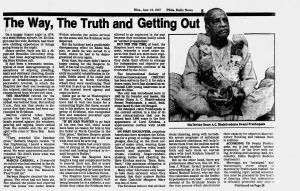
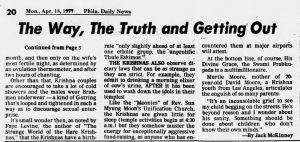
NEW YORK TIMES MAGAZINE, Mexico, May 1 1977
Sharing son with Hare Krishna
By Judith Wax
If you have original (good quality) article, contact [email protected]
New York Times, August 9 1977
A Reuther Wedding, Krishna Style, in a Palace by Fisher
By ANGELA TAYLORAUG
DETROIT — Like Kubla Khan in Xanadu, Lawrence P. Fisher had a pleasure palace built in 1929. However, the automobile magnate's place with its gardens and, fountains, its huge pseudo‐Moorish rooms with painted ceilings and pillars inlaid with gold (not to mention a swimming pool, bowling alley, miniature golf course and boat dock for his 100‐foot yacht) was setin East Detroit, an area that began to deteriorate after the Depression. His dream of an earthly paradise disappeared with the real estate slump.
Mr. Fisher, who was the first president of Cadillac Motors, and a member of the Body by Fisher family, was a bachelor when he arranged for the building (he married later) and there are all sorts of legends of his playboy days: Gatsby‐like parties complete with movie stars and a closet full of negligees from which his favorities could choose.
The former Fisher mansion was full of music and flowers and dancing last weekend. Not jazz‐age Charlestons, but the wailing music of the sitar and flutes and the repeated chanting of “Hare Krishna.” The estate now belongs to the International Society for Krishna Consciousness and the Detroit temple was celebrating one of its happiest events, a wedding.
Fords Stay Away
Since Detroit is synonymous with cars, even a Hare Krishna wedding doesn't get too far from the automotive industry. The bride was Lekhasravanti, who was born Elisabeth Luise Reuther, daughter of Walter Reuther, president of the United Automobile Workers, who was killed in a plane crash in 1970. The bridegroom was Bhusaya (formerly Bruce Dickmeyer of Mankato, Minn.) and the best man was also a devote, Ambarish (Alfred Ford, great grandson of the founder of the Ford Motor Company and nephew of Henry Ford 2d).
There were no Fords visible among the guests, who left their shoes at the door and then padded barefoot up the tile staircase to be garlanded with flowers, but the bride's uncles, Ted and Victor Reuther, their wives and sons came. So did the Dickmeyers, parents and grandparents of the bridegroom, and his seven sisters and brothers, virtually all armed with cameras, who said they were enchanted with the bride.
Victor Reuther looked around at the past splendors of the Fishers and remarked: “When I think that this building was built with the sweat of the auto workers—what if the walls have ears, what would they think about a Reuther being married in these surroundings?”
Lisa Reuther and Alfred Ford met in the Krishna movement when they joined it four years ago. When the temple had the opportunity to buy the estate almost two years ago, Miss Reuther gave her inheritance and Mr. Ford lent the rest. It was his idea that this should be a splendid wedding with thousands of flowers flown in from as far as Hawaii for the garlands and decorations.
The temple bustled with activity from dawn on Saturday. Male devotees in khurtas and dhotis (loose shirts and sarong‐like garments) built the canopy for the ceremony, young women in saris covered the marriage platform with silk and cushions and arranged the gifts of fruits and flowers to Krishna, laid the ceremonial fire and arranged the herbs and spices and ghee (clarified butter) that the priest would pour on the fire.
In the basement kitchen, more devotes prepared the lavish vegetarian feast (Krishna followers eat no animal food except milk products and are forbidden alcohol and even coffee, tea or Coco‐Cola, to be arrayed on rented silver for the 200 guests.
Sari‐clad female devotees padded around on bare feet, arranging flowers for centerpieces and making garlands to decorate the mansion's former ballroom and: the guests. A Hare Krishna orchestra arrived from California.
The bride and bridegroom were the only temple members who did not work that day. Lekhasravanti, who is 30, wore‐a diamond nose ring, a gift from Goverdan, the temple president.
“A married woman should wear a nose ring,” she explained. “Alto have red painted on the part in her hair and dotted on her forehead. It means good luck for her husband.”
Her hands and feet were painted in intricate red patterns that took an Indian member of the temple four hours to do. The bridegroom changed his saffron bachelor's dhoti for a cream silk one, but had‐no ornamentation except the telok, the white mark made of Ganges clay painted on his nose. His hair was cropped except for the sikha, the long back lock—“so Krishna can grab you and take you to heaven.”
A Goal Like Her Father's
Both had entered the temple four years ago. “I wanted to help people,” Lekhasravanti said, her blue eyes serious. The Reuther aunts and uncles had not objected. “I'm a mature woman. What we're doing in a spiritual way is what my father did. He believed in the dignity of man.”
The young couple have been living in the temple, where the living quarters for the sexes are strictly segregated. They have bought a small house nearby, where they will live together. They both work in book distribution for the Krishna movement.
When it was time for the bride to dress in the bedroom of the late Mrs. Fisher, who seems to have preferred French boiseries to Moorish tiles, four Indian ladies, their voices as soft and gentle as doves, arrived to array the bride. First, they combed her long, brown hair intp a series of puffs at the back and pinned roses around the puffs. Carefully, they painted the telok and dotted arches of red and white over her brows.
The gorgeous, gold‐encrusted crimson sari was pleated and draped over the long petticoat and short choli shirt. As an unmarried woman, the bride would not drape the scarf over her head until after the ceremony. Then the bride's head, neck and arms aere draped with the special jewels that belong to the temple.
Exchange Garlands
In the ballroom, the bare‐footed guests sat in silence. The bridegroom and. best man took the lotus position on the cushion. Music wailed. The bride appeared alone and sat on her cushion.
The priest intoned, made various sacrifices of herbs to Krishna. The gueses chanted. The couple exchanged garlands and gold rings. Their hands were wrapped together with flower garlands by the best man, who tied his dhoti to her sari as a symbol of lasting marriage.
Victor Reuther kissed his niece and, giving his new nephew a playful pinch in the arm, said, “I like this man.”
It's possible that the ghost of Lawrence Fisher would have liked the lavishness of this party. And, apparently, he had his compassions. When, after Mrs. Fisher's death in 1968, Gilbert Groehn bought the house, he found two silver caskets holding dogs buried in the garden.
Mr. Groehn, a manufacturer of burglar alarms, owned the house for two years and used it mainly to test his security devices. He called the house the Casa Alarmica.
The Daily News, August 18 1977
Krishna, Who they are? What do they do?, Why the concern?

Anderson Daily Bulletin, November 5 1977
What if your child joins the cult?
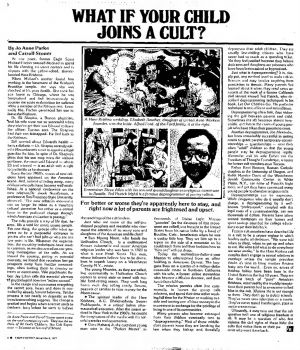
The Guardian, November 16 1977 India
Krishna leader dies in India
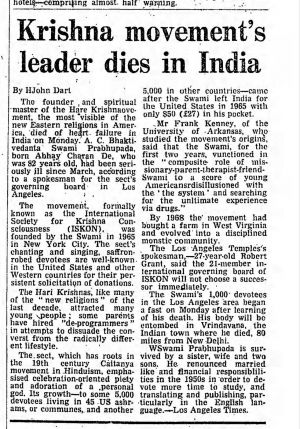
The Philadelphia Inquirer, November 16 1977
Deaths Elsewhere
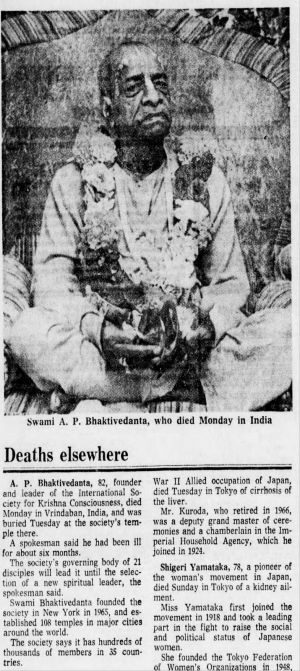
Honolulu Star Bulletin, November 20 1977
In Memory
